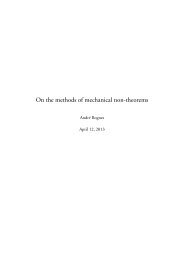Examples of questions
Examples of questions
Examples of questions
You also want an ePaper? Increase the reach of your titles
YUMPU automatically turns print PDFs into web optimized ePapers that Google loves.
FYS3410 – Solid State Physics: List <strong>of</strong> <strong>questions</strong><br />
Periodic structures<br />
1. Lattice: Main definitions – unit cell (primitive and conventional), Wigner-Seitz cell. Main symmetry<br />
operations for a lattice, allowed rotation axes.<br />
2. Bravais and-non Bravais lattices. Bravais lattices in two dimensions.<br />
3. Bravais lattices and crystal systems in three dimensions.<br />
4. Body-centered cubic (bcc), face-centered cubic (fcc), and hexagonal close packed (hcp) lattice:<br />
Primitive and conventional cell. Packing ratio.<br />
5. Diamond structure and cubic zinc sulfide structure.<br />
6. Index system for crystal directions and crystal planes. Distance between the planes expressed<br />
through Miller indices.<br />
7. Notion about non-ideal crystal structures: Stacking defects and polytypes.<br />
Wave diffraction and reciprocal lattice<br />
1. Bragg’s law: General principle and typical numbers<br />
2. Laue equations and reciprocal lattice. Rules for construction <strong>of</strong> reciprocal lattices.<br />
3. <strong>Examples</strong> <strong>of</strong> reciprocal lattices for cubic and hcp crystals<br />
4. Ewald’s construction and its justification.<br />
5. Brillouin zones. <strong>Examples</strong> <strong>of</strong> Brillouin zones for sc, bcc, fcc and hcp lattices.<br />
6. Diffraction amplitude: Expression through atomic form-factor.<br />
7. Scattering from a lattice with basis: Structure factor.<br />
8. Structure factor for bcc and fcc lattice.<br />
9. Main experimental methods for wave diffraction in crystals.<br />
Crystal binding<br />
1. Van der Waals (molecular) bonding: Basic notion and estimates.<br />
2. Ionic bonding: Basic notion and estimates. Madelung constant.<br />
3. Covalent bonding: : Basic notion and estimates.<br />
4. Metallic bonding: : Basic notion and estimates.<br />
Elastic properties<br />
1. Stress and strain tensors.<br />
2. Hook’s law. Elastic constants: Meaning <strong>of</strong> different constants.<br />
3. Elastic energy density for cubic crystals. Bulk modulus and compressibility.<br />
4. Elastic waves in isotropic media and cubic crystals.<br />
Lattice vibrations<br />
1. Mono-atomic 1D lattice: Dispersion relation, phase and group velocity.<br />
2. Diatomic 1D lattice: Dispersion relation, phase and group velocity.
3. Three-dimensional lattices: Acoustic and optical modes.<br />
4. Quantization <strong>of</strong> lattice vibrations: Phonons, conservation laws for phonon-assisted scattering <strong>of</strong> X-<br />
rays and neutrons.<br />
5. Density <strong>of</strong> vibration states for different dimensions <strong>of</strong> the lattice. Debye and Einstein models.<br />
6. Lattice contribution to heat capacity.<br />
7. Anharmonic interactions and thermal expansion.<br />
8. Lattice contribution to thermal conductivity.<br />
Free electron Fermi gas<br />
1. Electrons in a box: Wavefunctions and eigenvalues.<br />
2. Electron density <strong>of</strong> states in 1, 2 and 3 dimensions.<br />
3. Fermi distribution: Chemical potential and Fermi energy.<br />
4. Electron heat capacity: Estimate and calculation.<br />
5. Drude model for conductance: Main assumptions and expression for conductivity.<br />
6. Origins for finite collision time: Basic scattering mechanisms and temperature dependence <strong>of</strong><br />
conductivity.<br />
7. Electron contribution to thermal conductivity: Wiedemann-Franz law.<br />
8. Motion in magnetic field: Cyclotron resonance and classical Hall effect.<br />
9. Conductivity and resistivity tensors in magnetic field.<br />
Energy bands<br />
1. General properties <strong>of</strong> electrons in a crystal: Bloch theorem.<br />
2. Dispersion relation for electrons in a periodic potential: Brilluoin zones and band structure.<br />
3. Number <strong>of</strong> states in a band and velocity <strong>of</strong> a Bloch electron.<br />
4. Band structure in a weak periodic potential.<br />
5. Band structure in a tight-binding approximation.<br />
6. Concept <strong>of</strong> effective mass: Weak and strong periodic potential.<br />
7. Insulators, semiconductors, semimetals and metals.<br />
Metals<br />
1. Fermi surface: Basic concepts, reduced and extended zone schemes.<br />
2. Fermi surfaces for free electrons and for typical metals (role <strong>of</strong> periodic potential).<br />
3. Classical mechanics <strong>of</strong> electrons in metals in a magnetic field.<br />
4. Bohr-Sommerfeld quantization <strong>of</strong> electrons in metals.<br />
5. De Haas - Van Alphen effect in metals.<br />
6. Main experimental methods to study Fermi surfaces in metals: Fermi surface <strong>of</strong> Cu as an example.<br />
Semiconductors<br />
1. Band structure <strong>of</strong> semiconductor and its manifestation in optical absorption.<br />
2. Effective masses in semiconductors: Basic properties and typical numbers.<br />
3. Intrinsic semiconductors: Density <strong>of</strong> states, chemical potential, concentration <strong>of</strong> charge carriers.<br />
4. Impurity states: donors and acceptors. Temperature dependence <strong>of</strong> carrier concentration.
5. Mobility, its temperature dependence due to different scattering mechanisms.<br />
6. Band structure <strong>of</strong> concrete semiconductors: Si and GaAs.<br />
7. Thermoelectric effects.<br />
Point defects and dislocations; surfaces and interfaces<br />
1. Schottky and Frenkel defects, their origin and temperature dependence <strong>of</strong> their concentration.<br />
2. Diffusion, Fick’s law.<br />
3. Edge and screw dislocations, Burgers vector.<br />
4. Surfaces, interfaces and basic semiconductor devices (MOSFET, HEMT)
















